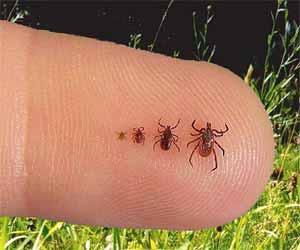- Home
- Editorial
- News
- Practice Guidelines
- Anesthesiology Guidelines
- Cancer Guidelines
- Cardiac Sciences Guidelines
- Critical Care Guidelines
- Dentistry Guidelines
- Dermatology Guidelines
- Diabetes and Endo Guidelines
- Diagnostics Guidelines
- ENT Guidelines
- Featured Practice Guidelines
- Gastroenterology Guidelines
- Geriatrics Guidelines
- Medicine Guidelines
- Nephrology Guidelines
- Neurosciences Guidelines
- Obs and Gynae Guidelines
- Ophthalmology Guidelines
- Orthopaedics Guidelines
- Paediatrics Guidelines
- Psychiatry Guidelines
- Pulmonology Guidelines
- Radiology Guidelines
- Surgery Guidelines
- Urology Guidelines
Failure of Lyme disease treatment - Investigate for babesiosis

USA: Delayed diagnosis is common in patients with babesiosis, this is because almost half of the patients with the condition do not recall being bitten by a tick -- are the findings of a recent study published in the journal Open Forum Infectious Diseases.
Babesiosis, caused by a tick-borne parasite that infects red blood cells, is an emerging health risk and clinicians need to be aware of its different clinical manifestations. While mainly transmitted by ticks, rare cases have been reported following blood transfusion or solid organ transplantation. There are multiple Babesia species that cause human disease including B. microti, B. divergens, B. duncani, and B. venatorum.
Also Read: New Draft Lyme Disease Guidelines released by IDSA/AAN/ACR
Key findings of the study include:
- No patients died, but 68% required hospitalization, and 21% were admitted to the intensive care unit.
- Co-infection with other tick-borne pathogens was fairly common in the 38 patients: 28.9% of patients also had Lyme disease and 10.5% had Anaplasma infection.
- Co-
infections were correlated with more severe symptoms. - The diagnosis was most often made in the summer months, peaking in July.
- Patients were usually diagnosed more than 2 weeks after symptom onset.
Also Read: New donor screening tests approved by FDA to make Blood Transfusion Safer
"The majority of patients who become infected are asymptomatic and never present for care," the authors concluded. "Due to the non-specific symptoms of babesiosis, diagnosis is often delayed…. In patients with a diagnosis of Lyme disease or Anaplasmosis, if there is no improvement after initiation of therapy, babesiosis should be suspected."
To read the complete study log on to https://doi.org/10.1093/ofid/ofz311

Disclaimer: This site is primarily intended for healthcare professionals. Any content/information on this website does not replace the advice of medical and/or health professionals and should not be construed as medical/diagnostic advice/endorsement or prescription. Use of this site is subject to our terms of use, privacy policy, advertisement policy. © 2020 Minerva Medical Treatment Pvt Ltd